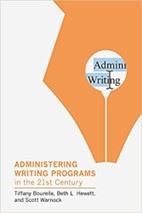Publication Details
| OLOR Series: | OLOR Reviews |
| Author(s): | Leah F. Cassorla |
| Original Publication Date: | 1 September 2022 |
| Permalink: |
<gsole.org/olor/reviews/2022.09.01> |
Resource Overview
Media, Figures, Tables |
Resource Contents
Review of Administering Writing Programs in the Twenty-First Century
The last two and a half years have shown academics that we cannot simply continue with business as usual. In particular, the Covid-19 pandemic made clear that the ability to pivot, to teach online or hybrid, and to teach online literacies are among the most pressing needs of academic institutions. Into this breech, Tiffany Bourelle, Beth L. Hewett, and Scott Warnock have stepped, offering Administering Writing Programs in the Twenty-First Century. This book is a companion volume to Teaching Writing in the Twenty-First Century, in which the authors make constant references to this administration volume, clearly underscoring the “companion” nature of the books.
As the authors note in considering the challenges facing Writing Program Administrators in the current moment:
The rules of civic (and civil) engagement have changed with digitality. People interact in face-to-face settings, of course, but they also often communicate using text message, email, social media, video meetings, and phones, especially in times of required physical distancing. (p. 10)
While the authors identify the challenges of online teaching and learning, the book focuses on the ways a new or veteran WPA can lead writing programs through the current challenges, challenges that include digital literacy, digital access, inclusion, and “the myriad ways students’ lives and backgrounds influence communication and composition itself” (p. 1). While the authors provide in-depth information on ways instructors and their administrative structures must shift to focus on use of digital tools in more conscious ways, they also provide a framework for WPAs who must shepherd their program’s instructors through the changes wrought by digitality and pandemic to help their instructors see digitality as providing primary tools, but also—and especially in composition—to see digitality as subject matter:
The rules of civic (and civil) engagement have changed with digitality. People interact in face-to-face settings, of course, but they also often communicate using text message, email, social media, video meetings, and phones, especially in times of required physical distancing. On social and other digital platforms, people sometimes write hundreds of words daily. Such written communication moves students beyond the minimal writing that formal education requires and into consequential communication. . . . Digitality has changed communication to such an extent that educators must rethink how they address composition for private and public needs. (pp. 10-11)
The book offers seven chapters, each focused on a set of WPA tasks: "1. Building a Writing Program"; "2. Humanizing a Writing Program"; "3. Hiring Instructors"; "4. Training Instructors"; "5. Evaluating and Mentoring Instructors"; "6. Assessing Writing Programs"; and "7. Imagining the Future of Writing Program Administration." Each chapter unfolds using scenarios based on a. Fictional WPA, Garcia and an instructor in her program named, Professor Jackson. The examples are used to highlight common, compellingly realistic issues, particularly in facing the ways in which composition instruction is changing in the digital age:
Now that WPA Garcia has hired new instructors, she has a few months to create professional development content and processes for them. . . . She is not sure where to start, as her instructors have a wide range of experience: some have taught for years but have never taught fully online courses or multimodal composition and others have online experience but have no solid knowledge of rhetorical history and strategies that should inform their writing classes. She has not even observed the teaching of all her current faculty members, those who have been at the institution for years, like Professor Jackson. Frankly, WPA Garcia is unsure where to start the training or how to make sure that professional development is ongoing without overburdening writing instructors’ already high workload. (80)
While each chapter offers unique suggestions and insights, including self-care as a form of professionalization for WPAs and instructors, by their own reference throughout the introduction, chapter 4 contains the most immediately important information as it deals with pedagogical concerns, cultural competencies, assignment scaffolding, access, ePortfolios, graduate teaching assistants, and training. Each of these subjects is considered through the lens of digitality and the importance of maintaining and teaching digital literacies. For example, in considering the diversity of contemporary college students, the authors explain that:
[E]ducators may not have sufficient knowledge about their own diverse student populations. WPAs should include the voices of all students, faculty members, and administrators within the training, in addition to using texts and media from a variety of authors. From a trainer’s standpoint, trainees must understand that inclusion is made possible through knowledge and strategies that enable proactive design of their courses. (p. 86)
Though the book is focused on the work of WPAs, along with its companion book, Teaching Writing in the Twenty-First Century, it functions to set and guide compositionists, and composition as a field, toward a more effective approach to teaching composition and literacy in the digital age. Administering Writing Programs in the Twenty-First Century allows classroom instructors to position themselves in the bigger picture of their institution’s program and also in the comprehensive context of writing programs in institutions throughout the U.S. The collective experience and publications of Bourelle, Hewett, and Warnock put this book in the “must read” category for GSOLE members.
 Administering Writing Programs in the Twenty-First Century
Administering Writing Programs in the Twenty-First Century
By Tiffany Bourelle, Beth L. Hewett, and Scott Warnock. Modern Language Association, 2022. [Paperback, $36.00; ebook, $30.99-$35.99].


